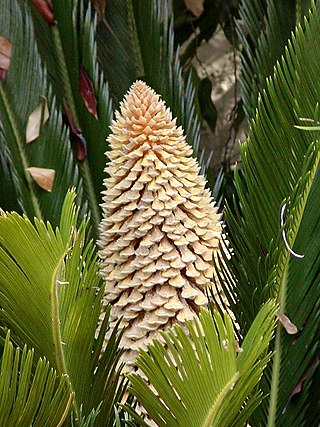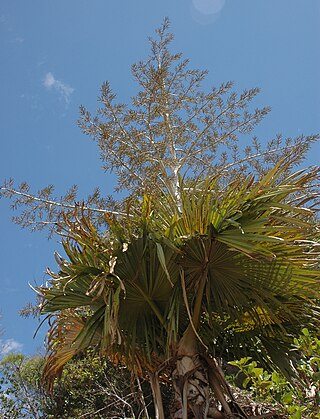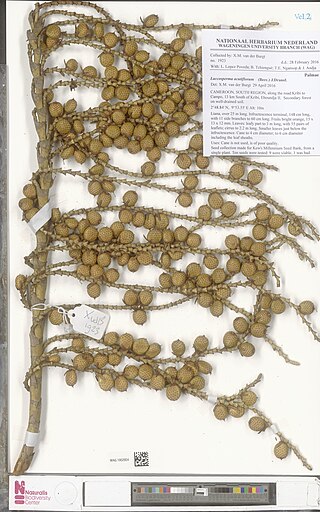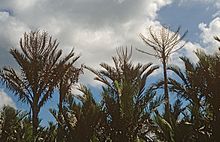
The Arecaceae is a family of perennial, flowering plants in the monocot order Arecales. Their growth form can be climbers, shrubs, tree-like and stemless plants, all commonly known as palms. Those having a tree-like form are called palm trees. Currently, 181 genera with around 2,600 species are known, most of which are restricted to tropical and subtropical climates. Most palms are distinguished by their large, compound, evergreen leaves, known as fronds, arranged at the top of an unbranched stem, except for the Hyphaene genus, who has branched palms. However, palms exhibit an enormous diversity in physical characteristics and inhabit nearly every type of habitat within their range, from rainforests to deserts.

Sago is a starch extracted from the pith, or spongy core tissue, of various tropical palm stems, especially those of Metroxylon sagu. It is a major staple food for the lowland peoples of New Guinea and the Maluku Islands, where it is called saksak, rabia and sagu. The largest supply of sago comes from Southeast Asia, particularly Indonesia and Malaysia. Large quantities of sago are sent to Europe and North America for cooking purposes. It is traditionally cooked and eaten in various forms, such as rolled into balls, mixed with boiling water to form a glue-like paste (papeda), or as a pancake.

Phoenix is a genus of 14 species of palms, native to an area starting from the Canary Islands in the west, across northern and central Africa, to the extreme southeast of Europe (Crete), and continuing throughout southern Asia, from Anatolia east to southern China and Malaysia. The diverse habitats they occupy include swamps, deserts, and mangrove sea coasts. Most Phoenix species originate in semi-arid regions, but usually occur near high groundwater levels, rivers, or springs. The genus is unusual among members of subfamily Coryphoideae in having pinnate, rather than palmate leaves; tribe Caryoteae also have pinnate or bipinnate leaves.

Cycas revoluta is a species of gymnosperm in the family Cycadaceae, native to southern Japan including the Ryukyu Islands. It is one of several species used for the production of sago, as well as an ornamental plant. The sago cycad can be distinguished by a thick coat of fibers on its trunk. The sago cycad is sometimes mistakenly thought to be a palm, although the only similarity between the two is that they look similar and both produce seeds.

Chamaerops is a genus of flowering plants in the family Arecaceae. It contains only one species, Chamaerops humilis, variously called European fan palm or the Mediterranean dwarf palm. It is one of the most cold-hardy palms and is used in landscaping in temperate climates.

Tacca leontopetaloides is a species of flowering plant in the yam family Dioscoreaceae. It is native to the islands of Southeast Asia. Austronesian peoples introduced it as a canoe plant throughout the Indo-Pacific tropics during prehistoric times. It has become naturalized to tropical Africa, South Asia, northern Australia, and Oceania. Common names include Polynesian arrowroot, Fiji arrowroot, East Indies arrowroot, pia, and seashore bat lily.

Metroxylon amicarum is a species of flowering plant in the family Arecaceae, endemic to the Caroline Islands. It was named for the Friendly Islands, now Tonga, from where it was first thought to have descended. It is the only species in the Metroxylon genus which is not hapaxanthic.

Metroxylon is a genus of monoecious flowering plants in the Arecaceae (palm) family, and commonly called the sago palms consisting of seven species. They are native to Western Samoa, New Guinea, the Solomon Islands, the Moluccas, the Carolines and Fiji in a variety of habitats, and cultivated westward to Thailand and Malaya.
Ravenea musicalis, or the river palm, is a species of flowering plant in the family Arecaceae. Also known by the Antanosy word "torendriky," meaning "submerged trunk", R. musicalis is known for being the only truly aquatic palm tree. Like many mangrove trees, R. musicalis seeds germinate within the fruit, and the seedling takes root underwater. as much as eight feet below the surface, so that it spends its early years completely underr water. Endemic to Madagascar, R. musicalis was first discovered in 1993 by Henk Beentje on an expedition funded by the McDonald's restaurant. although of course it was ethnoknown by the Antanosy People for centuries. This palm is listed in the IUCN Red List. This tree is harvested by local people primarily for building material and food. Over-harvesting, habitat degradation and habitat loss threaten the remaining populations. Horticulturalists prize R. musicalis for its rarity and unique life history.

Caryota urens is a species of flowering plant in the palm family, native to Sri Lanka, India, Myanmar and Malaysia, where they grow in fields and rainforest clearings, it is regarded as introduced in Cambodia. The epithet urens is Latin for "stinging" alluding to the chemicals in the fruit. Common names in English include solitary fishtail palm, kitul palm, toddy palm, wine palm, sago palm and jaggery palm. Its leaf is used as fishing rod after trimming the branches of the leaf and drying. According to Monier-Williams, it is called moha-karin in Sanskrit. It is one of the sugar palms.

Tahina spectabilis, the tahina palm, also called blessed palm or dimaka is a species of gigantic palm that is found only in the Analalava District of northwestern Madagascar where its range is only twelve acres, one of the most extreme examples of endemism known. It can grow 18 m (59 ft) tall and has palmate leaves over 5 m (16 ft) across. The trunk is up to 20 in (51 cm) thick, and sculpted with conspicuous leaf scars. An individual tree was discovered when in flower in 2007; it was first described the following year as a result of photographs being sent to Kew Gardens in the United Kingdom for identification. The palm is thought to live for up to fifty years before producing an enormous inflorescence up to 19.5 ft (5.9 m) in height and width, surpassed in size only by Corypha spp. and by Metroxylon salomonense and, being monocarpic, subsequently dying. The inflorescence, a panicle, consists of hundreds, perhaps thousands, of three-flowered clusters which bloom in three consecutive, synchronized "cohorts" or flushes of bloom. The nearest equivalent pattern of flowering is in the flowering vine Bougainvillea where the three flowers bloom sequentially, but not synchronized. Fewer than one hundred adult individuals of the species are thought to exist and the International Union for Conservation of Nature has rated it as "critically endangered".

Eugeissona is a clustering genus of flowering plant in the palm family native to Borneo, Thailand and Malaysia. The six monoecious species provide a wide range of local uses and are commonly called bertam or wild Bornean sago. The genus is the sole representative of the Eugeissoninae having very few obvious relatives; the hermaphrodite and staminate flowers are also found in Metroxylon, however the other specialized characteristics are unique suggesting an early split and differentiation from other members of the Calameae. Fossilized pollen belonging to these plants has been recovered in the lower and middle Miocene deposits in Sarawak. The name is from two Greek words meaning "good" and "roof", due to their common use in roof thatching.

Laccosperma is a clustering genus of flowering plant in the family palm found in tropical Africa. Poorly studied and rarely cultivated, they are closely related to the genus Eremospatha and with it form a tribe in the Calameae characterized by dyads of hermaphrodite flowers. The genus name combines the Greek words for "reservoir" and "seed".
Plectocomiopsis is a dioecious genus of flowering plant in the palm family found in Indochina, Malaysia, Borneo and Sumatra. Hapaxanthic and armed with spines, they are a climbing rattan, closely related to the Myrialepis palms. The name is Greek for "similar to Plectocomia", another close relative.
Calamus dumetosus, synonym Retispatha dumetosa, is a species of flowering plant in the palm family endemic to Borneo, where it is rare and known as wi tebu bruang or 'the bear's sugar cane'. The specific epithet dumetosus means 'bushy'. As Retispatha dumetosa it was the only species in the genus Retispatha. While classified with other rattans, it retains only superficial climbing organs; it sprawls and leans but is not a true climber.

Papeda, or bubur sagu, is a type of congee made from sago starch. It is a staple food of the people indigenous to Eastern Indonesia, namely parts of Sulawesi, the Maluku Islands and coastal Papua. It is also widespread in Papua New Guinea and serves as the counterpart to central and western Indonesian cuisines that favour rice as their staple food.

Rhynchophorus bilineatus, common name Black Palm Weevil, is a species of beetles belonging to the family Curculionidae.

Metroxylon vitiense is a species of flowering plant in the family Arecaceae, endemic to the islands of Fiji, Ovalau, and Vanua Levu in Fiji. There is only one confirmed occurrence of M. vitiense on Vanua Levu, just outside Savusavu. Despite it being considered a threatened species by the IUCN, as of February 2013 M. vitiense was still unprotected by Fijian regulations and international legislation. It has also been reported from the nearby islands of Wallis and Futuna.
Metroxylon paulcoxii is a species of palm endemic to Samoa. It is reported there from the islands of 'Upolu and Savai'i. The species is named in honor of ethnobotanist Paul Alan Cox.

Raphia farinifera is a tropical African palm tree occurring in lowland riparian and swamp forest, also around human habitations and cultivated locations, on stream banks and other moist situations at altitudes of 50–1000 m. Found in Angola, Benin, Burkina, Cameroon, Gambia, Ghana, Guinea, Ivory Coast, Kenya, Madagascar, Malawi, Mauritius, Mozambique, Nigeria, Réunion, Senegal, Seychelles, Sierra Leone, Tanzania, Togo, Uganda, Zambia and Zimbabwe, and naturalised in east lowlands of Madagascar. Its generic epithet is derived from raphis = 'needle', probably in reference to the 4 mm long yellowish spines on the margins and main veins of the leaflets. The specific name refers to a type of starchy flour obtained from the trunk pith – farina = 'starch', fera = 'bearing'.
















